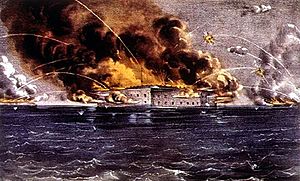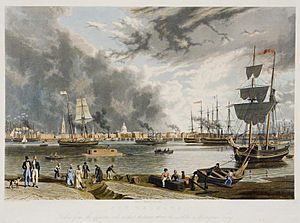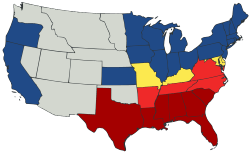Causes of the American Civil War facts for kids

Most academic scholars identify slavery as a central cause of the American Civil War. Slavery was the central source of escalating political tension in the 1850s. The Republican Party was determined to prevent any spread of slavery, and many Southern leaders had threatened secession if the Republican candidate, Lincoln, won the 1860 election. After Lincoln won, many Southern leaders felt that disunion was their only option, fearing that the loss of representation would hamper their ability to promote pro-slavery acts and policies.
Contents
Slavery
Slavery was a major cause of disunion. Slavery was illegal in much of the North, having been outlawed in the late 18th and early 19th centuries. It was also fading in the border states and in Southern cities, but it was expanding in the highly profitable cotton districts of the rural South and Southwest. The strategy of the anti-slavery North was to stop the expansion and thus put slavery on a path to gradual extinction. The slave-holding South denounced this strategy as infringing upon their Constitutional rights. Southern whites believed that the emancipation of slaves would destroy the South's economy, due to the large amount of capital invested in slaves and fears of integrating the ex-slave black population.
Sectionalism

Sectionalism refers to the different economies, social structure, customs and political values of the North and South. It increased steadily between 1800 and 1860 as the North, which phased slavery out of existence, industrialized, urbanized, and built prosperous farms, while the deep South concentrated on plantation agriculture based on slave labor, together with subsistence farming for poor freedmen.
States' rights
The South argued that each state had the right to secede - leave the Union - at any time, that the Constitution was a "compact" or agreement among the states. Northerners (including President Buchanan) rejected that notion as opposed to the will of the Founding Fathers who said they were setting up a perpetual union.
Territorial crisis
Between 1803 and 1854, the United States achieved a vast expansion of territory through purchase, negotiation, and conquest. At first, the new states carved out of these territories entering the union were apportioned equally between slave and free states. It was over territories west of the Mississippi that the proslavery and antislavery forces collided.
Both the South and the North came to the same conclusion: "The power to decide the question of slavery for the territories was the power to determine the future of slavery itself."
Lincoln's election
The election of Abraham Lincoln in November 1860 was the final trigger for secession. Southern leaders feared that Lincoln would stop the expansion of slavery and put it on a course toward extinction. The slave states, which had already become a minority in the House of Representatives, were now facing a future as a perpetual minority in the Senate and Electoral College against an increasingly powerful North. Before Lincoln took office in March 1861, seven slave states had declared their secession and joined to form the Confederacy.
Images for kids
-
President Andrew Jackson viewed South Carolina's attempts to nullify the tariffs of 1828 and 1832 as being tantamount to treason.
-
Slaves working in the fields, on the Confederate $100 bill, 1862–63. On the left is John C. Calhoun, on the right Columbia.
-
John J. Crittenden, author of the Crittenden Compromise bill, December 18, 1860
-
Stephen A. Douglas – author and proponent of the Kansas–Nebraska Act of 1854
-
Platform of the American Anti-Slavery Society, founded in 1833 by William Lloyd Garrison and Arthur Tappan
-
A woodcut from the abolitionist Anti-Slavery Almanac (1839) depicts the kidnapping of a free African American with the intention of selling him as a slave.
-
Abolitionist Frederick Douglass
-
Radical abolitionist John Brown
-
Slave Dred Scott
-
William H. Seward, Secretary of State under Abraham Lincoln and Andrew Johnson
-
"Vote yourself a farm—vote yourself a tariff": a campaign slogan for Abraham Lincoln in 1860
-
Henry Wilson, author of History of The Rise and Fall of the Slave Power in America (1872–1877)
See also
 In Spanish: Orígenes de la Guerra de Secesión para niños
In Spanish: Orígenes de la Guerra de Secesión para niños




















